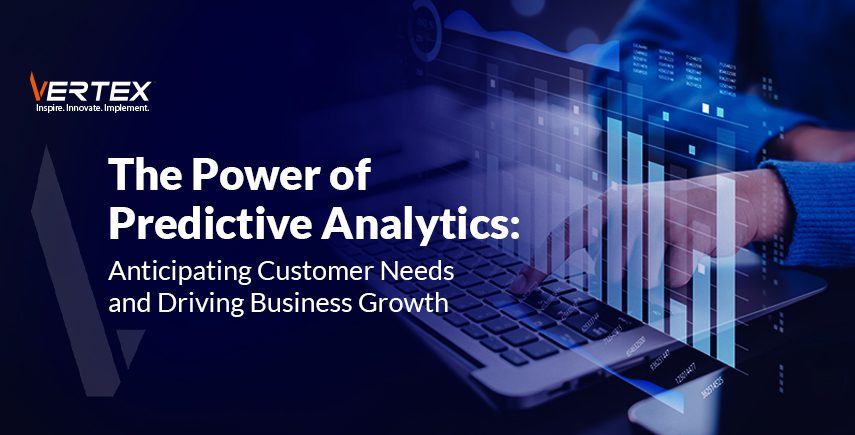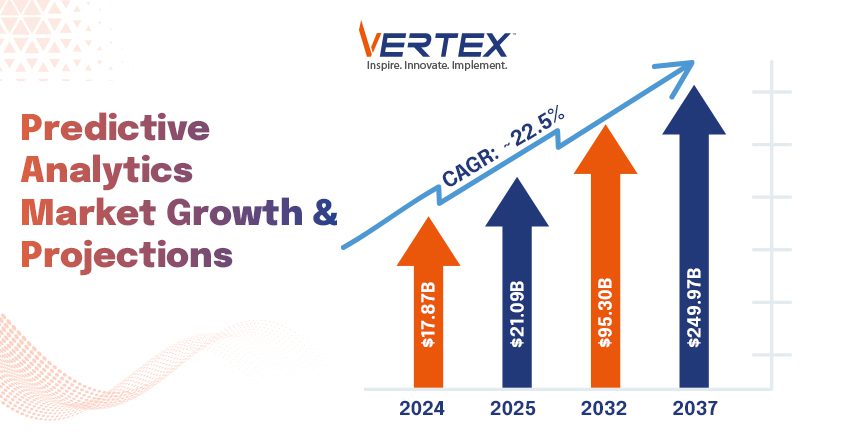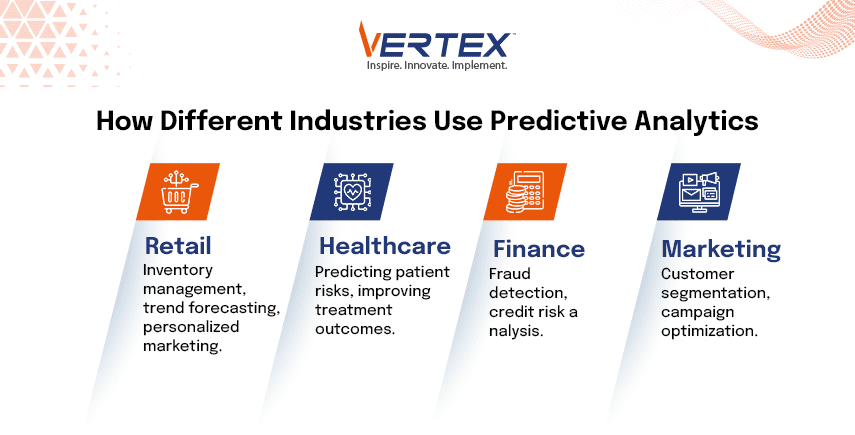
Mani Pattathil
December 16, 2024The Power of Predictive Analytics: Anticipating Customer Needs and Driving Business Growth
Understanding what the customer wants is something we all have wondered and strived to understand. Some companies or businesses have cracked the code, and they are flourishing. Now, the answer to this age-long question lies within bulks of DATA. Data reading and analyzing is the solution, and Predictive Analytics is the accurate term.
Understanding customer behaviour enhances decision-making and drives growth for any business. Most organisations are now dependent on data-driven insights to curate strategies. With this, the predictive analytics market is heading for significant expansion. In this article, we will learn about predictive analytics and its application in different industries.
What is Predictive Analytics
Predictive analytics is done by using data (old and present), statistical algorithms, and machine learning techniques to identify future outcomes. Through this, we identify patterns in data, and these insights help businesses make predictions and develop strategies curated for our customers. By analysing patterns in data, businesses can make informed predictions about customer behaviour, market trends, and operational performance. Predictive analysis not only helps in predicting strategies, but it also helps us prepare for any coming opportunities or challenges. The market for predictive analytics is all set for expansion, as quoted by the Institute of Data in their report, which states that revenue will jump from $14.71 billion in 2023 to $67.66 billion by 2030.

Market Growth and Projections
The predictive analytics market is experiencing robust growth. Various companies and businesses support this claim. The below-mentioned reports work as testaments.
- Research Nester mentioned in one of their reports that the predictive analytics market is valued at approximately USD 17.87 billion in 2024 and is projected to reach USD 249.97 billion by 2037, expanding at a compound annual growth rate (CAGR) of around 22.5% from 2025 to 2037.
- According to Fortune Bussiness, the market will grow from USD 14.71 billion in 2023 to USD 95.30 billion by 2032, at a CAGR of 23.1% during this period.
- By 2025, the global predictive analytics market size is expected to hit USD 21.09 billion, as reported by Precedence Research.
Benefits of Predictive Analytics
Predictive analytics offers numerous benefits across various sectors, such as marketing, finance, and healthcare. Making it an essential tool for every sector, the use of these tools can improve a lot of factors, which are mentioned below:
- Improved Decision-Making: Organizations can make data-driven decisions that lead to better strategic planning and resource allocation. They can also make strategies regarding new products or offers depending on consumer behaviour.
- Enhanced Customer Experience: Businesses can use predictive analysis to make their customer service experience more personalised. This will significantly improve customer satisfaction and will attract more customers. They can achieve this by designing campaigns and customer interactions based on data and predictive insights.
- Risk Management: Predictive analytics helps identify potential risks before they escalate into major issues, allowing organisations to mitigate losses effectively. This can help a business survive and come back stronger.
- Optimised Operations: Businesses can streamline supply chain management and resource allocation through accurate demand forecasting. This will ensure a proper flow of supply and demand.

Applications Across Industries
Predictive analytics is being utilized across various industries to enhance business operations some of them are mentioned below.
Retail
In retail business, predictive analytics helps forecast trends and even customer preferences. These predictions are based on the data extracted from the previous consumers and even the present ones. With this, any retail business can keep track of inventory and create marketing campaigns. Businesses can also stock up on the most sold items and least sold items by looking over consumer purchase patterns.
Healthcare
In healthcare, predictive analytics is used to analyze the patient’s data and medical records. By doing this, we can identify at-risk patients beforehand. We can also create data charts containing the patient’s old medical history to foresee any significant outcome. According to a report by Statista, more than 92% of the healthcare leaders in Singapore are in the process of adapting predictive analytics in their healthcare organisations. China is second with an adoption rate of 79%, followed by the U.S.A. and Brazil both at 66%.
Financial Services
Financial institutions use predictive analytics for risk assessment and identifying fraud. Banks can identify anomalies that indicate fraudulent activity by analysing transaction patterns. This approach not only protects assets but also improves overall operational efficiency.
Marketing
In marketing, predictive analytics allows businesses to segregate their customers more efficiently. After studying the behavioural patterns of customers, organizations can tailor their marketing strategies to meet the specific needs of different segments. This targeted approach increases conversion rates and enhances customer loyalty. According to a report by Salesforce, more than 91% of top marketers are now fully committed to adapting to predictive analytics.
Statistical Insights into Predictive Analytics
Several key statistics support the growth trajectory of the predictive analytics market:
- The North American market is expected to grow at the fastest rate, with an estimated value of USD 6.63 billion in 2024, rising at a CAGR of 21.52% through the forecast period. This is covered in a report by Precedence Research.
- A significant driver for this growth is the exponential increase in data generated from various sources, such as IoT devices and digital platforms, necessitating advanced analytical tools for actionable insights. As quoted by the Grand View Research.
Challenges in Implementing Predictive Analytics
Despite its advantages and diverse use cases, many companies and businesses have a hard time implementing this to their use. We have identified some of these problems for you.
Data Privacy Concerns
The number one issue companies have with such software is their privacy, many businesses do not feel comfortable sharing all the data with such tools. This is also backed by the increasing scrutiny on data privacy regulations, such as GDPR; organisations have a tough time navigating their way through such conditions while leveraging customer data insights.
Integration with Existing Systems
Integrating predictive analytics tools with legacy systems can be complex as the old systems are not optimised to run such advanced software. These software are running on LLM and ML and these require a system that is boosted with the latest hardware.
Skill Gaps
There is a notable shortage of skilled professionals who can effectively analyze data and derive actionable insights from predictive models. We need professionals who are trained in AI interfaces and using LLM-based software.
Future Trends in Predictive Analytics
As we look ahead, several trends are shaping the future of predictive analytics:
- AI Integration: The integration of artificial intelligence (AI) will enhance the accuracy of predictive models by enabling more sophisticated and more complex analyses of large datasets.
- Real-Time Analytics: The demand for real-time insights will be greater, and this will make service-based businesses adopt predictive analytics. Through this, they will be able to speed up the process and deliver results.
- Cloud-Based Solutions: Cloud computing will help deploy predictive analytics solutions across various business functions.
- Automated Predictive Models: Advancements in automation will streamline the creation of predictive models, making it easier for organizations to implement these tools without extensive manual intervention.
Conclusion
Predictive analytics is a powerful tool for anticipating customer needs and driving business growth across various sectors. In this read, we understood the
implementation of predictive analytics in different organisations. Predictive analytics will help shape the business’s growth and make the process more streamlined. You should also adapt these tools to your business or organisation for better results.
Recent Blogs

28 April, 2025

21 April, 2025

14 April, 2025

7 April, 2025

24 March, 2025

17 March, 2025

10 March, 2025

3 March, 2025
Recent News

2 February, 2025

14 November, 2024

4 November, 2024

1 August, 2024

6 March, 2024

28 February, 2024

12 June, 2023



